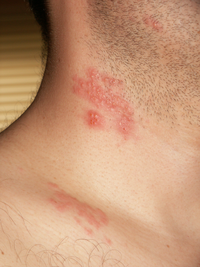
Photo from wikipedia
Dermatomyositis sine dermatitis (DMSD) is one of the rare idiopathic inflammatory myopathies. Based on predominant symptoms faced by patients, it is classified into 3 types: (1) classic dermatomyositis (DM), where… Click to show full abstract
Dermatomyositis sine dermatitis (DMSD) is one of the rare idiopathic inflammatory myopathies. Based on predominant symptoms faced by patients, it is classified into 3 types: (1) classic dermatomyositis (DM), where patients have both muscle and skin symptoms; and (2) amyopathic DM, when only skin symptoms present with no muscle involvement. Whereas (3) DMSD has mainly muscle symptoms with muscle antibodies but no skin rashes. There have been only nearly 10 published articles about DMSD proving this disease’s scarcity. At the same time, it shows the importance of discussing the unusual presentation of such a rare disease. Here we present, a 28-year-old woman with worsening proximal muscle weakness. The decreased muscle strength on physical examination and elevated creatinine kinase required more work up for autoimmune disease. Interestingly, on muscle biopsy, anti-melanoma differentiation-associated gene 5 (anti-MDA5) antibody returned positive, and the patient responded well to 3 days course of steroids. The lack of skin involvement, the predominance of muscle symptoms, and positive anti-MDA5 antibody indispensably diagnosed patients with DMSD. The previously published articles have proved the association between anti-NXP-2 antibody and DMSD, which was not seen in our case. The systemic involvement of DMSD can lead to interstitial lung disease, where due to diffuse alveolar damage and pulmonary fibrosis, patients end up requiring intubation and may be associated with higher-level mortality. In our case, chest X-rays and computed tomography (CT) scans were unremarkable for lung involvement, so as no paraneoplastic syndromes were present, which has also been reported in DMSD patients previously.
Journal Title: Journal of Investigative Medicine High Impact Case Reports
Year Published: 2022
Link to full text (if available)
Share on Social Media: Sign Up to like & get
recommendations!